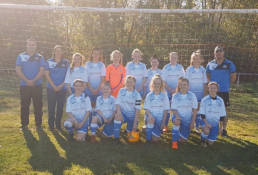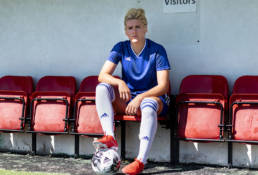Throughout this article we’ll take some different perspectives on the growth of women’s football. We’ve got predictions on what the future might hold from football finance guru Dr Rob Wilson, a grassroots view from South Wales and England’s Millie Bright tells us where the ‘missing link’ is when it comes to female participation.
Earlier this year, Barclays announced that it would become the first ever title sponsor of The FA Women’s Super League in a landmark deal. It’s understood to be worth upwards of £10m over a 3 year period. Clearly big brands are finally sitting up and taking notice of the Women’s game and putting their money where their mouths are. adidas also joined the party earlier in the year when they declared that their sponsored athletes competing in this summer’s World Cup would receive the same performance bonuses as their male counterparts.
Meanwhile, in the media, we’ve seen the likes of Alex Scott, Eni Aluko and Chelsea manager Emma Hayes take the punditry world by storm. England head to this month’s World Cup fresh off the back of SheBelieves Cup success and there’s now an expectation that they will go deep into the tournament and be among the favourites.
The Expert View
We took the opportunity to pick the brains of Sheffield’s own football finance guru Dr Rob Wilson. He has given us his take on the Barclays deal and the development of women’s football in general.
“The broadcast market has started to take a real interest, particularly organisations such as the BBC. This has increased exposure and larger businesses are beginning to see the value of the proposition. The women’s FA Cup Final demonstrated the power it is having with over 40,000 people in attendance plus a prime time media spot. You will also note that the BBC Sport Online web pages are full of content covering Womens Sport, sometimes making up 50% of the top stories.
The BBC has made it a centre piece for their coverage. This is much a result of the growth of the game but also strategic. They can’t compete with the pay broadcasters for the EPL so have gone after the WPL. This is working but the BBC have limited funds, making further investment challenging.
We will see a sharp increase in its popularity over the next 5 years, of that I have no doubt. It won’t reach the heights of the Men’s elite competition in the short or medium term but it will grow to become one of the top 5 most watched sports by 2025 in my opinion.
The next step is to get more people watching Women’s Football, both in the stadiums and on TV. The marketing agencies will be working hard to achieve that.”

The Grassroots Perspective
So it looks promising from an economic standpoint at the top end of the sport but what about those just starting on their footballing journeys? To get a perspective from grassroots level, we spoke to Andrew Lewis. Andrew is Club Secretary and U10s coach at Coed Eva Athletic Girls FC, a club that is helping to get more girls involved in football in South Wales.
“Seeing more Women’s Football on TV is a massive step forwards for the growth of the game. It’s not just important for children to watch but parents too, as they can then see that it’s another way for their daughters to get active, learn new skills, make new friends and most of all enjoy sport.
For young girls to have idols to look up to is great for their game. From the men’s game you’ve got the likes of Messi, Ronaldo, Hazard to name a few. But to have women like Alex Scott, Steph Houghton, Sophie Ingle and Jessica Fishlock so visible to them is special. It gives them the chance to dream of being in their shoes. This is a goal many of our girls want to reach in their futures, including wearing that national shirt.
I have the conversation about careers in football with many of my own players, including my daughter. They love football and they want to continue in the game as they get past the grassroots stage. I hope for all of them that if they don’t make it to a big club then they want to continue in our own adult women’s team, which is an ambition of ours.”

The View From the Top
Finally, whilst deep into her preparations for her debut World Cup, we were lucky enough to catch up with England and Chelsea FC Women defender Millie Bright. We asked her about her own experience of grassroots football when she was a youngster.
“I can’t really remember there being that much opportunity for me. I was very fortunate to come across a friend that was going to football training and I joined in for £1 and that was how I got into football. I think I was very fortunate that that happened otherwise I don’t think I would have known about my local team. I didn’t even know it existed. I definitely think that the opportunities have improved since when I was a kid and that’s the way we need to keep growing.
I only played in girls teams but I did most of my training with the boys. At school I was playing with the boys on the courts and getting involved in PE lessons. For me, that was where I got my aggression from, getting stuck in and loving a challenge because the boys were always better than me.
I think that to get more girls involved we just need to make opportunities more known. I don’t think that little girls know that there are opportunities out there for them and I don’t think that they know of teams. So we just need to make it more visible for them to know where to go to join a team or where to go to train.
I think it needs to be something where it’s not just parents that are noticing those things but kids can go to school or walk down the street and they can see something like a poster etc. I think that’s something that we need to figure out. It’s about making sure that girls know that there are places for them to get involved. That’s the missing link that we need to get sorted.”

It seems like women’s football has never been healthier and we expect interest to ramp up even further over the summer with the FIFA Women’s World Cup hitting our TV screens, inspiring the next generation of Millie Brights to pick up a pair of boots and a ball. The pressure of expectation is higher than ever but if the Lionesses can deliver in France, then the profile of the women’s game could be boosted even higher.
Keep your eyes peeled on our Blog and socials in the coming weeks as we have more women’s football content in the pipeline. Including a full length interview with Millie Bright, where she discusses the World Cup, grassroots football and much more.
How useful was this post?
Average rating 5 / 5. Vote count: 13
No votes so far! Be the first to rate this post.
